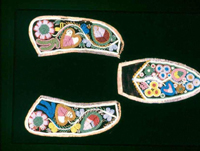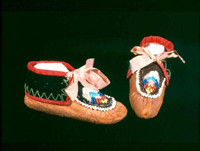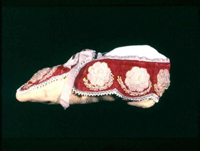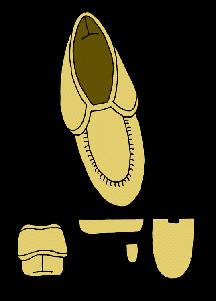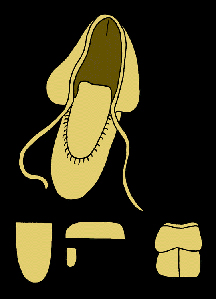Moccasins
The moccasins assembled here represent three distinct forms – a Mi’kmaq, Maliseet, Passamaquoddy and Penobscot style in which a wide vamp (toe) is pucker stitched to the sole and the heel portion has a vertical seam up the back; an Iroquoian form in which the heel seams form an upside down “T”; and a Great Lakes type in which a center seam runs down the top of the moccasin.
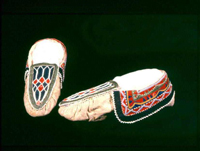 |
Penobscot Moccasins This pair of moccasins is inscribed: Maine Historical Society (1993.28) |
Maliseet Moccasin Toes and Cuffs, c.1870The large beaded design motifs (flowers and leaves) are delineated with paper patterns. Maine State Museum (86.37.1.1-6) |
|
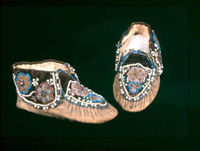 |
Maliseet Baby Moccasins, c.1840Nancy & Roger Prince (NTP 12) |
Among the Penobscot, moccasins intended for use in the woods were generally made from moosehide and those for winter use were made from moose hocks. Unlike their rugged moosehide counterparts, deer skin moccasins were beaded. Designs for moccasin tops and cuffs were worked on wool or velvet. These fabric panels were bound with ribbons and sewn onto the completed hide moccasins.
Iroquois-style child’s moccasins, c.1900These moccasins are decorated with a simple leaf design Nancy & Roger Prince (NTP 14) |
|
|
|
Ojibway-style Moccasin, c.1850Nancy & Roger Prince (NTP 11) |
Tuscarora-style Moccasin, c.1870Nancy & Roger Prince (NTP 10) |
|
As the decorative work was done on cloth and attached to hide moccasins, tops could be acquired from one tribe and sewn onto moccasins made by another tribe. Fannie Hardy Eckstrom, in The Handicrafts of the Modern Indians of Maine (1932) noted that in the 1870s, Penobscot moccasin makers acquired tops decorated with moosehair embroidery from the Huron and attached them to locally-made deerhide footwear.
|
Iroquois Moccasins
|
Penobscot Moccasins
|

